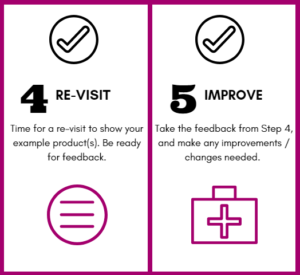
Hand knitting is getting more and more popular and people love handmade things. So why not make few extra dollars from that? You need more yarn right?
Getting your knitted items and handmade crafts to brick and mortar stores is actually easy. Not effortless, but easy. Follow these 5 steps and you should be good:
Step 1: find shops and stores;
Step 2: visit and ask questions;
Step 3: make samples and retouch;
Step 4: visit shops and stores with your example products;
Step 5: improve (if needed);
Let’s dig in:
Step 1

Make a research to find all shops and stores, where are knitted items on sale. Or shops that might want to sell knitted items, but don’t yet. Depending on your location it can be as easy as writing down one shop, or you can have a huge list of shops that might be best for you. Don’t over think this – just a list of shop names.
Use the Internet, ask from your friends or your knitting community, or simply take a walk in your home town to see which stores might be a perfect fit for you.
Keep an open mind when you’re doing your search, and don’t focus only on stores that sell handcrafted items – add those in your list too, of course, but think further. Think baby stores (knitted baby items), shops for accessories (scarves, hats, etc) and so on.
While you’re doing your research, it’s good to note down any extra information you find about the store:
- online address
- email address
- physical address
- managers name
- any notes, like what you love about this shop
etc.
Step 2

Now that you have your list ready to go, it’s time for a short visit.
Here’s what to look for (you can write everything down, but not while you’re in the store – do it later):
- do you like the shop (does it match your vibe and makes you feel good)? If not, cross it off your list and move on – don’t even bother with next steps;
- what items do you see?
- which items they have more of and which they have less of?
- what’s the price range?
- if you see customers, what are they looking at / buying (do not goggle 🙂 – that would be creepy)
- if you think that your knitted items may suit in this shop, ask from the person who works there, if they are open to check out your hand knitted items. If the salesperson doesn’t know, ask for the manager. There’s a reason you’re asking if they are open to check your items out, not if they are willing to take it in. They don’t know your work yet, so it’s important to give them room for backing up.
- if you got “no”: don’t worry, this is not an end of life. Usually they will tell you why it’s not a good fit for them and that’s ok. You just cross it off your list or put it on a stand by in case you want to try again later.
- if you got “yes”: great! Now is the time to ask what items they would be interested in, what items are sold the most, what colors are most popular at the moment and which yarn is most preferred. Ask anything that could help you choose a perfect product to make.
- don’t forget to ask a contact name and number in case you need it, and it also might be a good idea to give an approximate time frame, when should they expect your call;
Do not skip the question asking part thinking you will just offer them what you love to do. NO! Keep an open mind and be willing to knit items THEY want, not what you want. How badly you want that extra income from knitting?
What you should not ask (at least yet):
- if they will give you the yarn; remember, they don’t know you (yet) or how good is your work – you need to build trust first;
- how much are they willing to pay; it’s a research phase, you don’t know all the details that will go into the product and neither do they – hold this conversation to step 5;
Step 3
Based on your research and conversation, choose the product examples to make. Usually, I keep the choice down to 3 to 5 (unless otherwise is agreed), depending on the size of an item.
Few things to make a note of when you knit:
- how much materials did you use (per item);
- how much did your materials cost (per item);
- how much time did it take to make it (per item);
- other things that need to be remembered in case it happens to be a gold mine, like pattern you used, etc.
Make sure your sample items are clean and pretty. Wash and block (if needed and suitable). Don’t ever knit in a room where people smoke.
Also, it’s good to keep your items away from pets, especially when you’re working on baby items.
Oh, and don’t forget that presentation is everything, so if you’re getting ready to go to show your work, don’t through your items randomly into a bag. Find a nice box and wrap your item in a silk paper. Or something like this. I’m sure you get the idea. You are selling it to the store owner/manager first, and if you do this successfully, then they will sell your items successfully to customers.
Step 4 & 5 might overlap, so read both and take it as one step or two steps, depending on your situation.
Step 4

Time to go back to those shop owners/managers who agreed to take a look at your samples, but call first. Ask what day and/or time would be best for them for your visit.
Once you have agreed to meet, you should think few things through:
- what would be the price per item you’d be happy with; note that they are keeping the store and do all the selling for you, so don’t be unreasonable and be willing to negotiate;
- prepare yourself for some critique; it might be that you will hear some thoughts about your work you might not want to hear – be ready to accept it, and make improvements; also it’s good if you can add your own thoughts on how you can make improvements – that shows that you are thinking with them and you’re open to adjust;
- take note of anything that would help you improve your products and/or customer experience;
Remember – it’s all about co-operation, not who’s being right; they want to sell everything they have in store, and you want them to do that, so it’s best to find a middle ground here.
Naturally, everything stated here should be in reasonable lines. If the store owner demands a 100% wool yarn that doesn’t cause allergy then it’s unreasonable, and not in your power. In that case, you should politely educate them, and offer solutions.
Step 5
Make improvements/changes if needed and discuss the price. If the store owner knows something about cost of the yarn and what it takes to knit something, then you’re in luck. If not, let them know how much you would like to be paid per item, and include a cost of materials and approximate work hours for explanation. See what they say, and be willing to negotiate, but do not sell yourself short either.
We will talk about pricing your knitted items soon. In a meanwhile, just start and work your way to earning some money 🙂
I hope these steps were helpful and good luck!


